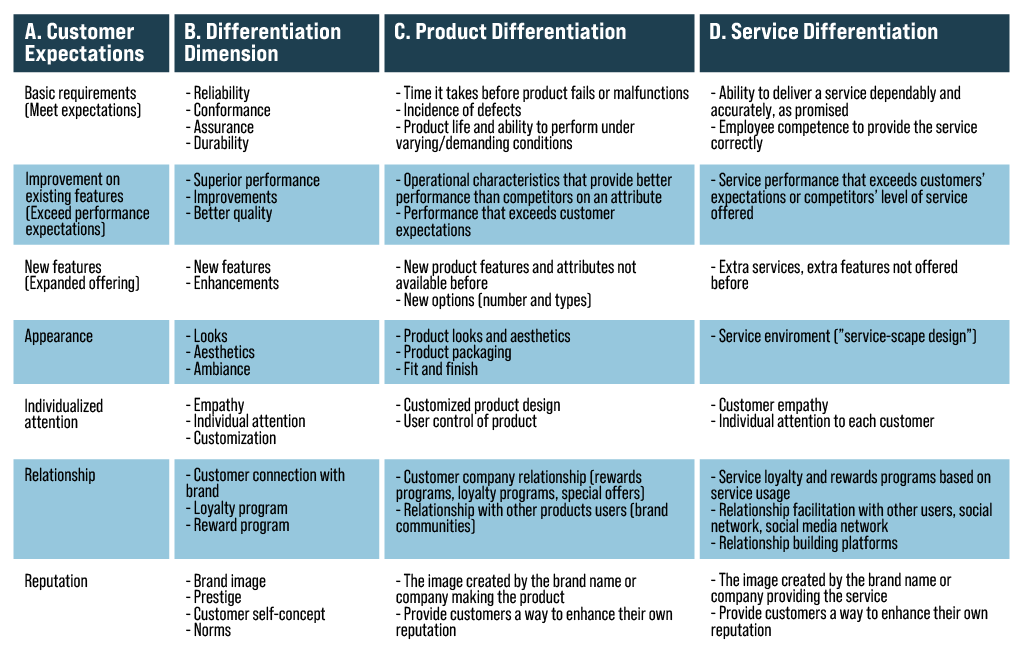From customers’ perspective, a market is commoditized when most competitive offerings are undifferentiated from each other. In such a market, customers can choose from the many available options without incurring any risk. Naturally, they gravitate toward the lowest price option. This forces competitors to aggressively compete on prices and erodes a brand’s pricing power. Over time, prices and profits decline. Therefore, differentiating its offerings from competitors is one of the most strategically challenging—and rewarding—tasks faced by a company.
A common mistake many executives make is to confuse adding product features with competitive differentiation. While the addition of product features can differentiate an offering, it is quickly replicated by competitors. Instead, companies should carefully evaluate the full spectrum of customers’ expectations and develop a differentiation strategy that is valued by customers. Figure 1 shows how companies can gain competitive advantage through differentiation.
FIGURE 1
Competitive Advantage Through Differentiation

There are several strategic considerations in gaining competitive advantage through differentiation.
– Carefully match your offering to customer expectations. Many product managers automatically assume that differentiation involves offering more product features. In fact, lasting differentiation can only be achieved by carefully aligning different aspects of your offering to customer expectations. For example, Honda and Toyota users place a high
weight on the basic requirement of reliability, durability, and assurance. That is why differentiation for these companies comes from a relentless focus on reliability. In contrast, Rolex is a brand whose customers expect and value reputational benefits. Thus, in addition to a high-quality product, Rolex ensures that the reputation of its brand in enhanced through advertising, communication and sponsorships.
– Don’t fall in the “Feature-Differentiation” trap. While new features can enhance an offering, they may not necessarily differentiate it in the customer’s eyes. Adding a feature that do not provide value to customers confuses them (why are they offering this?), causes resentment (I’m paying for features I don’t want), and causes feature fatigue (e.g., a remote control with too many buttons). This can reduce customer satisfaction which adversely impacts sales. Adding features that don’t provide customer value also increases the company’s costs. Ultimately, this erodes sales and margins.
– Service-based differentiation is critical in today’s world. Many companies that offer very similar products differentiate themselves through superior service. Service-based differentiation taps into intangible benefits that can be more important than physical product features. As shown in Colum D of figure 1, service-based differentiation can take
many forms. Thus competent, trained and certified mechanics at a car dealership provide customers with peace of mind. Polite and empathetic service representatives can help customers navigate product and service failures creating differentiation. Companies can also differentiate their offerings through service networks that are convenient and readily accessible to customers. Walmart’s large network of more than 11,000 stores is a core differentiator.
– A brand’s reputation matters. As shown in the last row of figure 1, reputation is an enduring and important source of differentiation. When customers feel that owning a brand enhances their image, identity and reputation they are likely to pay more for the product and engage in positive word-of-mouth. As an example, the reputational benefits associated with ultra luxury brands such as Rolex, Cartier, and Porche—differentiate them beyond product quality.
– Social media as a differentiator. Today, customers tell their stories online. When Danielle Lettering’s Stanley drink cup survived a car fire, the viral video (Figure 2) had more than 100 million views, and led to a $750 million lift in sales. Stanley offered to buy Danielle a new car, further differentiating its reputation as a caring company. Experiential and luxury brands differentiate themselves not just through the quality of their product but also by building brand communities on social media.
FIGURE 2
Stanley Drink Cup Survives a Car Fire
CONCLUSION: Differentiating a brand goes beyond simply adding more features. It requires careful consideration of customer needs going beyond physical features. If properly addressed, differentiation can enable firms to satisfy customers while increasing both sales and margins.
Learn more in Chapter 8 of Market-Based Management (7th edition). Chapter 1 can be reviewed online at www.mbm-book.com.
References:
- Thompson, Debora Viana, Rebecca W. Hamilton, and Roland T. Rust (2005), & Feature fatigue: When product capabilities become too much of a good thing & Journal of Marketing Research, 42(4), 431-442.
- Vega, Nicolas and Lauren Shamo (2023), “How a 40-ounce cup turned Stanley into a $750 million a year business,” CNBC make it, December 23, 2023.
